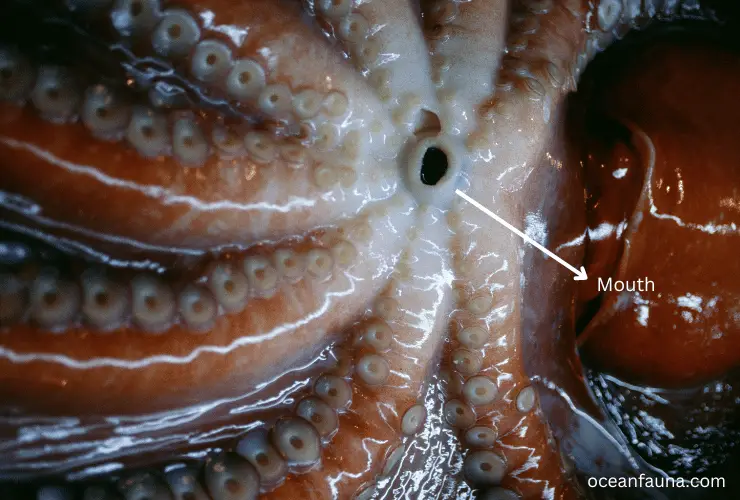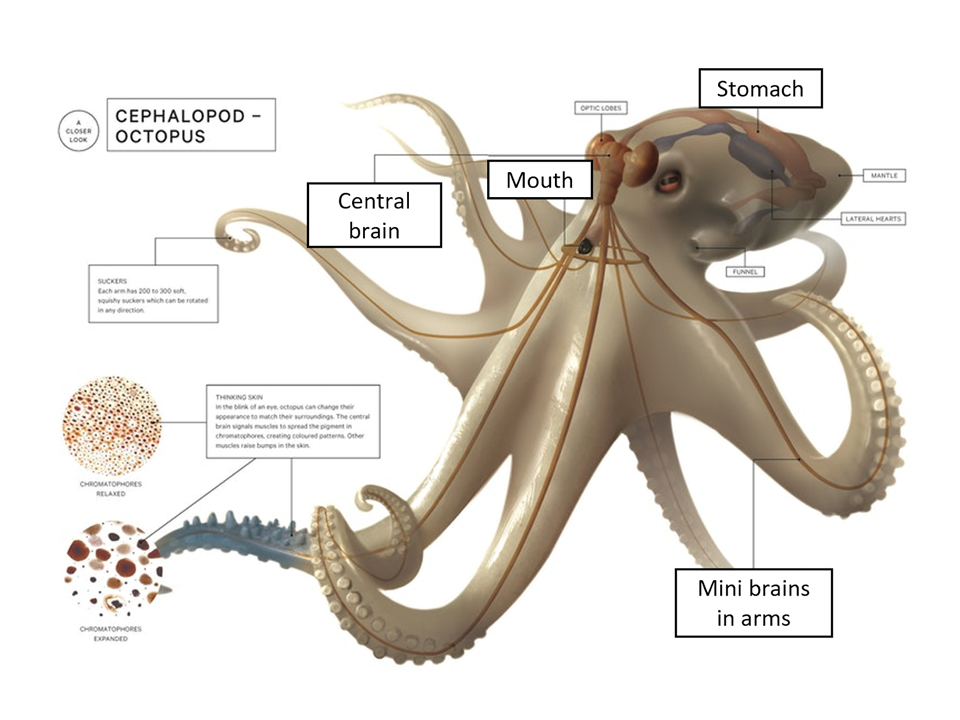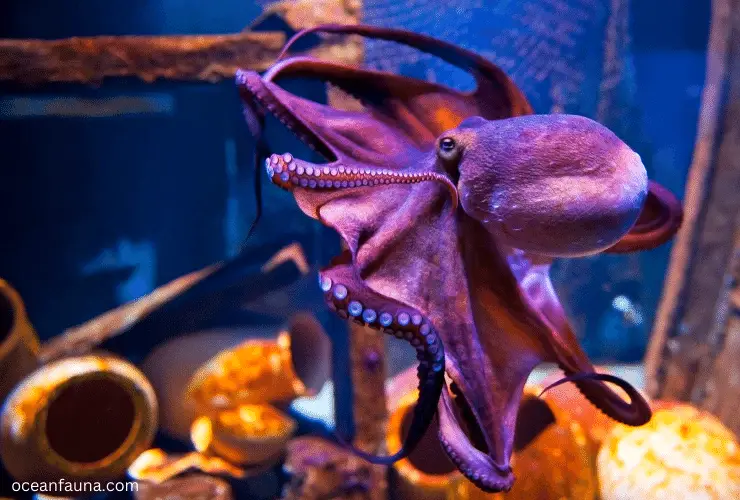The short answer is yes. To be specific, octopuses have beak-like structures around their mouth rather than a typical mouth like ours. Moreover, octopuses don’t have teeth like the classical sense.
There are another important part of the octopus’s mouth is the radula. It works as a tongue to scrape out the food from its prey.
These are the signs of how strange octopuses are compared to other marine creatures.
However, the anatomy of octopuses is even more complicated, and their mouth plays a significant role here. So, if you want to know more about their mouth, you’ve come to the right place.
So, let’s get started.
Do Octopus Have Mouths?
Yes. However, in contrast to the mouths of humans and other mammals, an octopus’s mouth serves merely to surround its one hard body feature, a beak like that of birds.
The octopus’s beak is the first portion of its digestive system, and it is located inside the buccal mass, also known as the mouthpart.

The beak is made up of two parts: the upper beak and the lower beak. A bridge and shoulder structure hold the upper and lower beaks together. Depending on the size of the octopus, the upper beak can range from 2.2 to 12.9 mm, while the lower beak can range from roughly 1.8 to 9.7 mm.
The octopus’s beak is not bone but rather more like a fingernail, but it is extremely durable.
The octopus’s principal salivary gland, the salivary papilla, is located in its mouth. Octopuses can create saliva, like most birds and reptiles, but it also contains paralyzing venom, making them a much more dangerous animal than fish.
An interesting fact is that octopuses can consume crabs despite their exoskeletons. Their salivary glands have a rigid portion that may be utilized to drill through hard things like clamshells.
Octopuses also throw venom to paralyse their prey. This venom comes from the salivary gland.
Nevertheless, the radula of an octopus can’t taste any food. But the tentacles have sensory glands that can detect food if it comes in contact with octopuses.
How Does an Octopus Mouth Help in Digesting Food?
The octopus’s diet is broken down with the help of its salivary glands’ digestive enzymes, its radula’s teeth-like structures, and its toughened scissor-like beak.
After a successful hunt, the octopus will bite its prey with its beak and inject its venom into the victim, whether or not the beak has to dig through the target. Paralysis sets in shortly after the venom is introduced into the prey.
After its victim has been rendered immobile, the octopus can use its beak to clamp down on the animal and divide it up into bite-sized chunks.
Octopus beaks are capable of cracking the shells of a variety of marine organisms, while larger shells may be too tough for the beak to penetrate. In this case, its powerful sucking tentacles may pry open the shells and extract the meat.
The radula, which is coated in teeth, aids the octopus in this situation by allowing it to “chew” through shells that would be difficult to open in any other way and remove any flesh that may be stuck inside.
What Does an Octopus Mouth Look Like?
Octopus’s mouth doesn’t look like a typical marine creature’s mouth. You’ll find their mouth where all of its tentacles meet. An octopus’s mouth has some important parts.
Let’s see what they are.
Beak
At first glance, you’ll not see octopuses’ beaks because they are hidden under tentacles and arms. It is more like a parrot beak but works as scissors. Moreover, beaks play an important role in hunting and crushing food.
There are two separate layers in their beaks. One is the outer hood, and the other is the inner wall. A bridge connects both these layers. The shoulder of an octopus helps its beaks to move.
And another important body part of an octopus is the radula which makes octopuses eleven more mysterious. Moreover, from the beaks, scientists got to know more about their diet and what’s mantle length of octopuses.
Octopuses’ beaks are among the sharpest of any animal, yet they also happen to be their strongest body parts. In an instant, it can crack open a shell or shred through flesh. Octopuses use the beak’s precision to extract prey from their shells. The octopus has a radula, a barbed tongue that sticks out of its beak. The beak can also serve as a drill.
The beaks have multiple purposes, including aiding in digestion and courtship. Octopuses can squeeze through openings of any size. Therefore, they rarely get stuck.
Radula
Radula works as a tongue of an octopus. The Radula consists of several parallel rows of teeth and spiny projections. Though the number and shape of teeth remain the same across species, the morphology of each row varies.
This unique configuration of teeth is useful for identifying many animal species. The radula is typically referred to by its two teeth, the outer lateral teeth (dental cusps) and the central tooth (dental apex).
So basically, this radula is covered by teeth. Octopuses use the radula to open the shell of their prey and scrape the food from it.

Radials are the individual teeth that make up an octopus’ Radula. The chitinous tissue they use can hold anything from 2,000 to 5,000 teeth. Hunting and gathering are one of their main roles since they scrape food off the floor.
Like octopuses, predatory sea snails use their teeth not only to scrape food but also as harpoons. The radula is used for cutting and capturing prey by predatory cephalopods.
An octopus’s Radula is an important link in the food web. Between the beak and the venom gland is a structure called the radula, which acts as the tongue. Small teeth cover the radula, which scrapes the meat off the shell.
The radula, or mouth, of an octopus releases saliva, that aids in the dismemberment of its victim.
Salivary Glands
After the beak and radula, the most important part of an octopus’s mouth is the salivary glands. These glands help in digesting food.
A central nervous system controls the octopus’s salivary glands and the poison centre.
Instead of forming synapses, the nerves that lead from the posterior salivary gland to the arms traverse the superior buccal lobe and return along a tube. This lack of a synaptic connection may be because the tube does not have reflex guidance or rhythmic secretion.
You’ll be surprised to know that an octopus can hold up to 50 types of different saliva in their mouth. This includes venom and other bioactive substances.
Although octopuses have some characteristics in common with cephalopods, their evolution has been remarkably distinct from that of other mollusks. Their divergent morphological configurations from those of cephalopods are strong evidence for their evolutionary isolation.
Substances like this stimulated the production of digestive enzymes. Also, these enzymes generate a cholesterol-metabolizing enzyme which helps digest the food.
Inc Sac
It is a unique defensive mechanism of cephalopods, including octopuses which helps them escape from their prey. They ejected the ink sac from their mouth.
Basically, whenever octopuses feel unsafe or get attacked by any predator, they discharge a huge amount of inc into the water. As a result, it discolors the water and blocks the predator’s view, enabling them to flee.
You’ll find this ink sac near the siphon. And it is designed in such a way that the ink is expelled by a water jet. The primary pigment of the ink is melanin which makes the water black.
No wonder octopuses are quite peculiar animals. And you can even make jewellery from this ink sac. Moreover, cephalopods like octopuses can mimic the surface of many different items on the ocean floor by altering the texture of their skin.
Is the Ink of the Octopus Toxic?
If octopus ink seeps into its gills, it can kill even an octopus. The ink consists of a harmless mixture of mucus and melanin, the same black pigment found in skin, hair, and eyes. Tyrosinase is an enzyme that can dull the scent and taste of a predator.
The fish could suffocate if the mucus mixture clogs its gills. Cephalopods like octopuses and squid use ink to confuse and stun would-be predators.
The ink of cephalopods is water-resistant. After some time, it breaks down into threads that seem like grey cobwebs and float aimlessly in the water, snagging on rocks.
It is possible that octopuses and other cephalopods will suffocate to death if they are trapped in ink for too long.
Conclusion
Octopuses have a mouth in the centre of the web of eight tentacles. This is the only part that can open up or close if octopuses want. Moreover, they have beaks similar to birds like parrots.
When it comes to consuming and breaking down food, the octopus employs its tough scissor-like beak and its radula coated in teeth-like features. Its salivary glands generate digestive enzymes.


1 thought on “Do Octopus Have Mouths?”